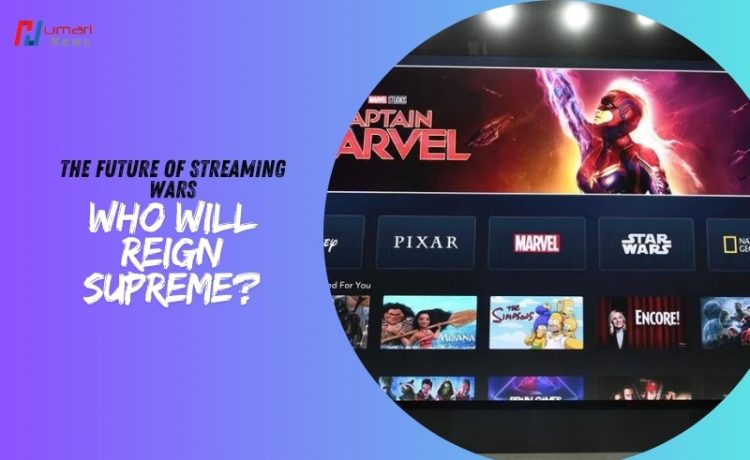The once-dominant reign of cable television has been fractured by the rise of streaming services. These platforms offer viewers a vast library of content on-demand and at an often lower cost, fundamentally changing how we consume entertainment. This has ignited a fierce competition between streaming giants, each vying for dominance in the “streaming wars.” But with a plethora of options bombarding viewers, who will ultimately emerge victorious?
A Crowded Playing Field: The Contenders

The streaming landscape boasts a diverse cast of characters, each with unique strengths and weaknesses:
- Netflix: The undisputed king for a long time, Netflix boasts a massive library of original content and licensed shows. However, rising production costs and subscriber churn raise concerns about future growth.
- Disney+: Backed by the immense library of Disney, Pixar, Marvel, Star Wars, and National Geographic, Disney+ has become a major force. Its focus on family-friendly content and nostalgia-driven programming resonates with a wide audience.
- Amazon Prime Video: Bundled with Amazon Prime memberships, Prime Video offers a compelling value proposition. While its library may not be as vast as Netflix or Disney+, it boasts critically acclaimed originals and attracts viewers with its fast-shipping benefits.
- HBO Max: Home to iconic HBO shows like Game of Thrones and Sopranos, HBO Max offers a premium streaming experience with high-quality content and adult-oriented programming. However, its higher price point might limit its reach.
- Apple TV+: A relative newcomer, Apple TV+ has established itself through critically acclaimed original shows and movies. However, its limited library compared to other services remains a challenge.
The Battleground: Content is King (and Queen)
The primary weapon in the streaming wars is content. Services are pouring billions of dollars into creating original shows and movies, alongside acquiring licenses for popular existing content. Here’s a breakdown of each contender’s content strategy:
- Netflix: The traditional leader, Netflix has produced a wide range of shows catering to various genres and demographics. However, the sheer volume has led to concerns about quality control.
- Disney+: Disney+ leverages its vast library to create originals capitalizing on nostalgia and brand loyalty. The Mandalorian and High School Musical: The Musical: The Series are prime examples.
- Amazon Prime Video: While Amazon offers a smaller library of originals, its shows tend to be critically acclaimed and have garnered devoted followings. The Boys and The Marvelous Mrs. Maisel are prime examples.
- HBO Max: HBO Max boasts a strong library of originals that build upon the prestige of the HBO brand. Succession and Euphoria exemplify its focus on high-quality, adult-oriented content.
- Apple TV+: Apple TV+ has made a name for itself with high-production-value originals. Ted Lasso and Severance have received critical acclaim, but the limited quantity of content remains a hurdle.
Beyond quantity and quality, exclusivity is another key factor. Offering shows and movies not available elsewhere can be a major draw for subscribers.
The Future: A Multi-Streaming World or Consolidation?
Predicting the ultimate victor in the streaming wars is a complex task. Here are some potential scenarios for the future:
- A Multi-Streaming World: Consumers may continue to subscribe to multiple services to access the specific content they desire. This scenario benefits services with strong niche offerings.
- Consolidation: The streaming market may see mergers and acquisitions, leading to a smaller number of dominant players. This could benefit services with strong financial backing.
- The Rise of Hybrid Models: A combination of streaming and traditional cable television subscriptions might become common, offering viewers a broader range of content options.
Ultimately, the future of streaming will likely be shaped by consumer preferences and the ability of services to adapt to changing viewing habits. The focus on creating high-quality, engaging content and offering a compelling value proposition will be paramount for any streaming service hoping to reign supreme.
Additionally, here are some emerging trends that could impact the streaming wars:

- The Rise of Free, Ad-Supported Streaming (FAST): Free, ad-supported streaming services like Pluto TV and Peacock could become more popular, offering viewers a budget-friendly option.
- The International Streaming Landscape: As streaming services expand globally, competition will intensify in new markets. Services will need to cater to local tastes and content preferences.
- The Power of Technology: Technological advancements like artificial intelligence and personalized recommendations could play a significant role in how viewers discover content and choose their streaming services.
The streaming wars are far from over, and the landscape continues to evolve. By staying adaptable and innovative, streaming services can carve out their niche and attract loyal viewers in the ever-changing world of entertainment.
The streaming wars have fundamentally transformed the entertainment landscape, offering viewers unprecedented control and choice. With a diverse cast of contenders vying for dominance, the question of who will ultimately reign supreme remains unanswered.
The battleground hinges on content. Services are locked in an arms race, pouring resources into creating high-quality originals and securing coveted licenses. Whether it’s Netflix’s sheer volume, Disney+’s nostalgic appeal, or HBO Max’s premium adult content, each contender offers unique strengths. Exclusivity plays a critical role, with services attracting viewers through content unavailable elsewhere.







